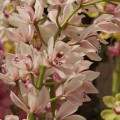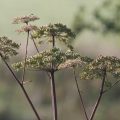- The Miraculous Shiny Bush Plant - January 18, 2021
- Colorful, Edible and Medicinal Celosia - January 10, 2021
- Radish, a Nutritional Power House - December 19, 2020
Arctostaphylos uva-ursi, commonly known as bearberry or pinemat manzanita, is a low-growing, evergreen plant of the heath family. It is native to Europe, Asia, and North America. The plant’s glossy and leathery green leaves normally take on a purple or red tinge in winter before turning to green again in spring.
[Disclaimer: Bearberry should not be consumed in large quantities as it is known to cause nausea, abdominal pain, and respiratory problems. These adverse effects are linked to tannins in the plant. And just because a plant is indicated as edible does not mean you should eat it unless you are doubly sure of its identity or effects on your body. In addition, The Right Flowers is not a medical site. Knowledge of and information about the therapeutic benefits and applications of flowers, while known through the ages, does not constitute medical advice. If you are having health issues, you should consult with a physician.]
Bearberry has ornamental value as its green foliage makes a perfect ground cover while its dainty pink or white waxy flowers produced between March and June break the monotony of the plant’s green mat, adding to the beauty of the garden. The lantern or bell-shaped flowers hang gracefully from red stems and stay open for weeks.
Pinemat manzanita is hardy and is rarely fussy, as it can withstand frost and dry weather conditions. However, the plant is hard to establish and a slow grower. Bearberry prefers sandy, well-drained soil in full sun but can still grow in partial shade.
The plant got the name bearberry from its association with bears. Grizzly and black bears love feeding on its berries especially during spring and autumn. The berries which are primarily red in color are also eaten by humans. In the raw form, they are less tasty, and dry. But when cooked, the berries taste like cranberries and are ideal for making cold beverages and jams. In addition, they are commonly used to enhance the taste of sauces and stews.
Aerial parts of the bearberry plant have been used to make herbal remedies for years. A popular technique of extracting the beneficial properties of the plant is to toss the leaves and flowers into a pan with hot water and allowing the mixture to stand for about 10 minutes. The resulting infusion is used to treat urinary tract problems, water retention, diabetes, fever, and indigestion.
To use bearberry for topical applications, the leaves and flowers are crushed to make a poultice that is applied to burns and wounds. The poultice is not only good for hastening the healing of the wounds, but it is also known to have antibacterial properties. In addition, the poultice is used to soothe back pain, and treat rashes, and rheumatism.
Bearberry is an ideal ornamental plant, a good source of food for humans, and a herbal remedy. Sounds like the perfect plant to have in your backyard, right?





